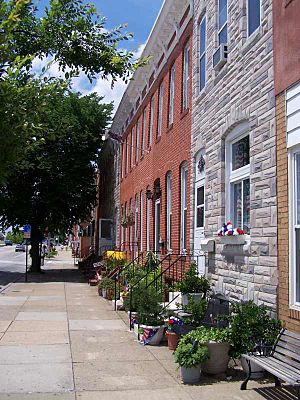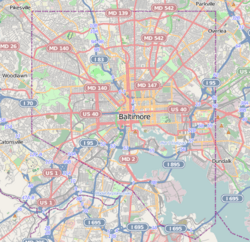Locust Point, Baltimore facts for kids
Quick facts for kids
Locust Point
|
|
|---|---|
|
Neighborhood of Baltimore
|
|

Traditional rowhouses on East Fort Avenue in Locust Point
|
|
| Country | United States |
| State | Maryland |
| City | Baltimore |
| Area | |
| • Total | .175 sq mi (0.45 km2) |
| • Land | .175 sq mi (0.45 km2) |
| Population
(2009)
|
|
| • Total | 1,858 |
| • Density | 10,620/sq mi (4,099/km2) |
| Time zone | UTC-5 (Eastern) |
| • Summer (DST) | UTC-4 (EDT) |
| ZIP code |
21230
|
| Area code | 410, 443, and 667 |
|
Locust Point Historic District
|
|
| Location | Roughly bounded by Fort Ave., B & O RR., Woodall & Reynolds Sts., Baltimore, Maryland |
| Area | 98 acres (40 ha) |
| Architectural style | Late Federal / Greek Revivals, Italianate, Queen Anne, Classical Revival, Gothic Revival |
| NRHP reference No. | 12001084 |
| Added to NRHP | December 26, 2012 |
Locust Point is a cool neighborhood in Baltimore, Maryland. It's located on a peninsula, which is a piece of land almost surrounded by water. The neighborhood is bordered by the Patapsco River on three sides.
Locust Point was once a major entry point for immigrants coming to the United States. Many families from Poland, Ireland, and Italy settled here. Today, the area has been updated with new homes and businesses.
This neighborhood is also famous for being home to Fort McHenry. This historic fort played a big role in American history. The Fort McHenry Tunnel, which carries Interstate 95 under the river, also starts here.
Locust Point was so important for immigrants that it was called "Baltimore's Ellis Island". From 1868 to 1914, over a million European immigrants arrived in Baltimore through Locust Point. It was the third busiest entry point in the U.S.
In 2012, the area was added to the National Register of Historic Places. This means it's recognized as a special place with important history.
Contents
History of Locust Point
Locust Point has a long and interesting history. It played a key role in the early days of the United States.
Fort Whetstone and the Revolution
In 1776, during the American Revolution, people in Baltimore built a fort. It was located on a piece of land called "Whetstone Point". This fort was named "Fort Whetstone". It was built to protect Baltimore Harbor.
The fort was almost attacked in 1777 by British ships. But the British fleet sailed elsewhere. Later, American troops led by George Washington camped near the fort. They were on their way to Yorktown, Virginia, to fight the British.
Fort McHenry's Beginnings
After the Revolution, the U.S. government rebuilt the fort. In 1798, a new star-shaped fort was finished. It was designed by a French military engineer named Jean Foncin. This new fort was named Fort McHenry, after James McHenry, who was the third U.S. Secretary of War.
When Fort McHenry was built, the area was mostly grassy fields. It was known as Whetstone Point. The City of Baltimore officially took over this land in 1816. In 1846, the area was renamed Locust Point. This was because of the many locust trees growing there.
War of 1812 and Beyond
Fort McHenry became famous during the War of 1812. In September 1814, it successfully defended Baltimore from British warships. This event inspired Francis Scott Key to write "The Star-Spangled Banner".
Many streets in Locust Point are named after heroes from the War of 1812. The oldest buildings in the neighborhood date back to the 1840s and 1850s. These are two-story houses on streets like Cuba, Clement, and Towson.
In 2013, a tornado hit the Locust Point area. It caused some damage to a nearby warehouse.
Industry and Business
Locust Point has been an important industrial area for a long time. Many businesses have operated here.
Procter & Gamble Plant
In the late 1920s, Procter & Gamble built a large factory in Locust Point. This factory made soaps like Ivory and Camay. It also produced liquid detergents like Joy and Dawn. Baltimore's strong industrial setup made it a good location.
However, in 1994, Procter & Gamble decided to close the Baltimore plant. Production stopped in 1995.
Tide Point and Under Armour
After the factory closed, a company bought the property in 1999. They turned the old soap factory into modern office spaces. This project was called Tide Point. It was a big step in updating the neighborhood.
Today, the sportswear company Under Armour has its headquarters at Tide Point. Three large silos next to their campus now have cool murals. They show famous athletes like Michael Phelps, Ray Lewis, and Cal Ripken Jr..
Port and Other Businesses
Locust Point is still a busy place for industry. The Helen Delich Bentley Port of Baltimore has two marine terminals here. These are places where ships load and unload goods.
The huge Domino sugar factory is also in Locust Point. These businesses show that the port is still very important for Baltimore's economy.
Community Life
Locust Point is a lively community with many places for residents and visitors.
Local Government
Locust Point is part of Baltimore City's 11th District. It is also part of Maryland's 46th Legislative and State Senate District.
Parks and Attractions
The neighborhood is home to several great places:
- The Baltimore Museum of Industry: A museum where you can learn about Baltimore's industrial past.
- Fort McHenry: A famous historic site where you can explore the fort and learn about the War of 1812.
- Latrobe Park: A nice park for outdoor activities.
- Locust Point Recreation Center: A place for sports and community events.
- Baltimore Water Taxi stop: You can catch a water taxi here to explore other parts of the city.
- South Locust Point Cruise Terminal: Where cruise ships dock.
- Francis Scott Key Elementary and Middle Grades School: A local school for kids.




